专科寄生虫和通才寄生虫在流行程度和感染强度上是否有所不同?对生态位宽度和权衡假设的检验。
IF 3.2
2区 医学
Q1 PARASITOLOGY
引用次数: 0
摘要
研究宿主特异性对于了解寄生虫向新宿主传播和引发疾病突发事件的能力至关重要。宿主特异性、寄生虫流行率和感染强度之间的关系通常是在两种相反的假设的背景下研究的。根据权衡假说,通才寄生虫可以感染广泛的宿主,由于适应多种宿主免疫系统的成本较高,通才寄生虫的流行率和感染强度将低于专才寄生虫。相反,生态位宽度假说认为,通才感染更多宿主物种的能力使他们在寄主群落中更有效,因此他们的患病率和感染强度更高。本研究旨在利用广泛分布的禽疟疾寄生虫疟原虫属和相关的疟疾样寄生虫嗜血杆菌来验证这些假设。对西班牙西南部17个地区的1188只野生家雀进行了寄生虫存在和感染强度筛查。对于发现感染家雀的每个谱系,我们估计宿主特异性为:i)根据MalAvi数据库,被该谱系感染的不同鸟类分类群的数量;ii)宿主物种之间系统发育相关性的指数。在419只家雀中发现寄生虫感染,鉴定出9种疟原虫和3种嗜血杆菌。流行率与寄主物种数量呈正相关。在更多的地方发现的谱系显示出更高的患病率和宿主范围。总之,这些结果支持生态位宽度假说与血寄生虫感染家雀有关。本文章由计算机程序翻译,如有差异,请以英文原文为准。

Do specialist and generalist parasites differ in their prevalence and intensity of infection? A test of the niche breadth and trade-off hypotheses
Studying host specificity is crucial to understanding the ability of parasites to spread to new hosts and trigger disease emergence events. The relationship between host specificity and parasite prevalence and infection intensity, has typically been studied in the context of two opposing hypotheses. According to the trade-off hypothesis generalist parasites, which can infect a broad range of hosts, will reach a lower prevalence and infection intensity than more specialist parasites due to the higher costs to adapt to multiple host immune systems. In contrast, the niche breadth hypothesis proposes that generalists’ ability to infect more host species makes them more efficient in colonising host communities and thus they are found at higher prevalences and infection intensities. This study aims to test these hypotheses using the widespread avian malaria parasites of the genera Plasmodium and the related malaria-like parasite Haemoproteus. Overall, 1188 wild house sparrows from 17 localities in southwestern Spain were screened for parasite presence and intensity of infection. For each lineage found infecting house sparrows, we estimated host specificity as i) the number of different bird taxa infected by that lineage according to the MalAvi database and ii) an index that accounts for the phylogenetic relatedness between the host species. Parasite infections were recorded in 419 house sparrows, and eight Plasmodium and three Haemoproteus lineages were identified. Prevalence was positively associated with the number of host species. Lineages found in more localities showed both higher prevalence and host range. Overall, these results support the niche breadth hypothesis in relation to blood parasites infecting house sparrows.
求助全文
通过发布文献求助,成功后即可免费获取论文全文。
去求助
来源期刊
CiteScore
8.40
自引率
2.50%
发文量
76
审稿时长
23 days
期刊介绍:
International Journal for Parasitology offers authors the option to sponsor nonsubscriber access to their articles on Elsevier electronic publishing platforms. For more information please view our Sponsored Articles page. The International Journal for Parasitology publishes the results of original research in all aspects of basic and applied parasitology, including all the fields covered by its Specialist Editors, and ranging from parasites and host-parasite relationships of intrinsic biological interest to those of social and economic importance in human and veterinary medicine and agriculture.

 求助内容:
求助内容: 应助结果提醒方式:
应助结果提醒方式:


